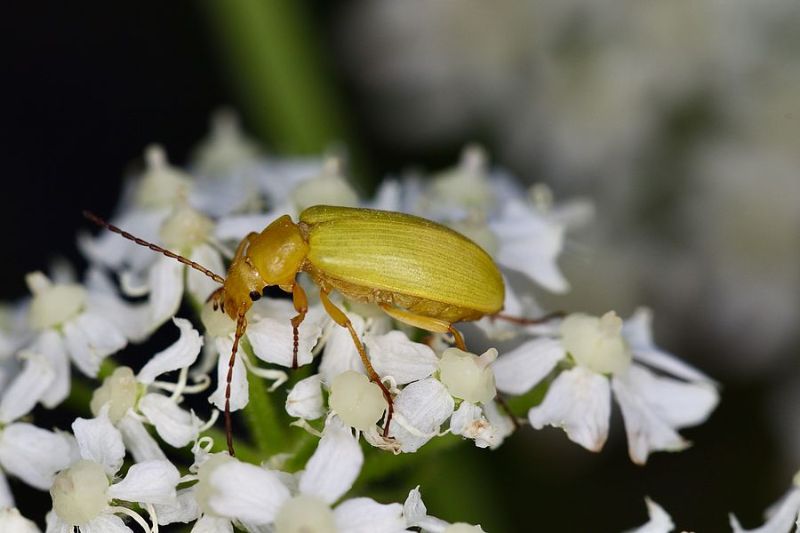Impoverished meadow and forest flora threatens insects
The intensification of land use poses a major threat to biodiversity, including herbivorous insects and their host plants. If beetles, Orthoptera (grasshoppers/crickets), Heteroptera (true bugs) and Auchenorrhyncha (cicadas/leafhoppers/treehoppers/planthoppers/spittlebugs) specialise in only one or just a few plant species, they have to migrate or else they become locally extinct when their host plants disappear. On the other hand, if an insect can feed on a wide range of species, it is able to survive even if the number of plant species declines. The interaction of species from different groups of organisms is ultimately a decisive factor in ecosystem stability.
Researchers from several research institutions in Germany and Switzerland, led by WSL, investigated these interactions between plants and insects. For the study, financed by the Swiss National Science Foundation (SNSF) as part of the German Research Foundation's (DFG) Biodiversity Exploratories Priority Programme, they examined the diversity of plants and insects, and the interactions between them, in three natural landscapes in Germany: the Swabian Alps (Baden-Württemberg), Hainich (Thuringia) and Schorfheide (Brandenburg). The study looked at a range of intensively to non-intensively farmed meadows and pastures (grassland), as well as beech and coniferous forests managed in different ways, with a view to finding out more about the interplay between plant and insect species making up local networks. The landscapes, each covering an area of up to 1,300 km2, encompass enough differently managed spaces to provide statistically reliable results.
The researchers assumed that they would find very diverse insect communities in the areas examined, which comprise a mix of near-natural ecosystems and those heavily used by humans. "Since some of these areas also contain insect species that specialise in a few food plants, we expected to gain new insights into the consequences of intensive land use for the ecological stability of grassland and forests," says WSL entomologist Martin Gossner, who led the study. In total, the researchers recorded 531 plant and 1,053 insect species and their abundance on 289 long-term sample plots.
More plant diversity means stabler insect communities
The study found that plant-insect networks in lightly grazed grassland comprised at least 70 plant species and 80 species of herbivorous beetles, Orthoptera, Heteroptera and Auchenorrhyncha. For example, the wild carrot, a typical plant of moderately grazed pastures, provides food for numerous specialist beetle species. In frequently mown or fertilised meadows and pastures, an average of only 40 plant species and 60 to 70 such insect species were detected.
In recently unmanaged forests with dense tree cover, biodiversity was significantly lower than in open forests, with an average of 25 plant species and 30 of the above-mentioned insect species. Those insects that rely on just a few tree or herb species as their food source cannot survive there. By contrast, in forests with many gaps in the canopy, a lot of light penetrates to the ground, and as a result up to 80 plant species and 50 herbivorous insect species from the groups studied were found there. "Light promotes a diverse range of plants, which in turn provide food for more insect species. At the same time, insect species are at less risk of becoming locally extinct, so the system is more stable," says WSL researcher Felix Neff, the lead author of a paper that has just been published in the journal Science Advances. An example of the stabilising effect of light-flooded forests is the nettle, which favours such environments and is a food source for many specialist caterpillars, weevils, Auchenorrhyncha and Heteroptera. "As a doctoral student, I've found this research fascinating, and not only because of the large, species-rich areas we've been investigating. For me, collaborating with the many interdisciplinary research groups has also been enriching," says Neff.
Results should be transferable to Switzerland
Promoting more open forests enhances the diversity not only of ground plants, shrubs and trees but also of the insect species that benefit from the diversity of plants. Mixed stands comprising different deciduous and coniferous trees are also beneficial, and should moreover prove to be more stable in the face of ongoing climate change. By contrast, where plant diversity decreases, the diversity of insects recorded, and therefore overall biodiversity, also decline. Such ecosystems become impoverished, in other words.
For grassland, the researchers recommend moderate grazing instead of intensive mowing in order to promote diverse and stable insect communities. "These findings can also be transferred to Switzerland, for example to the Swiss Plateau, the Jura or the lower elevations of the Alpine foothills," says Martin Gossner. "From the outset, the aim of the Exploratories project has been to draw conclusions that apply to different regions of Europe."
